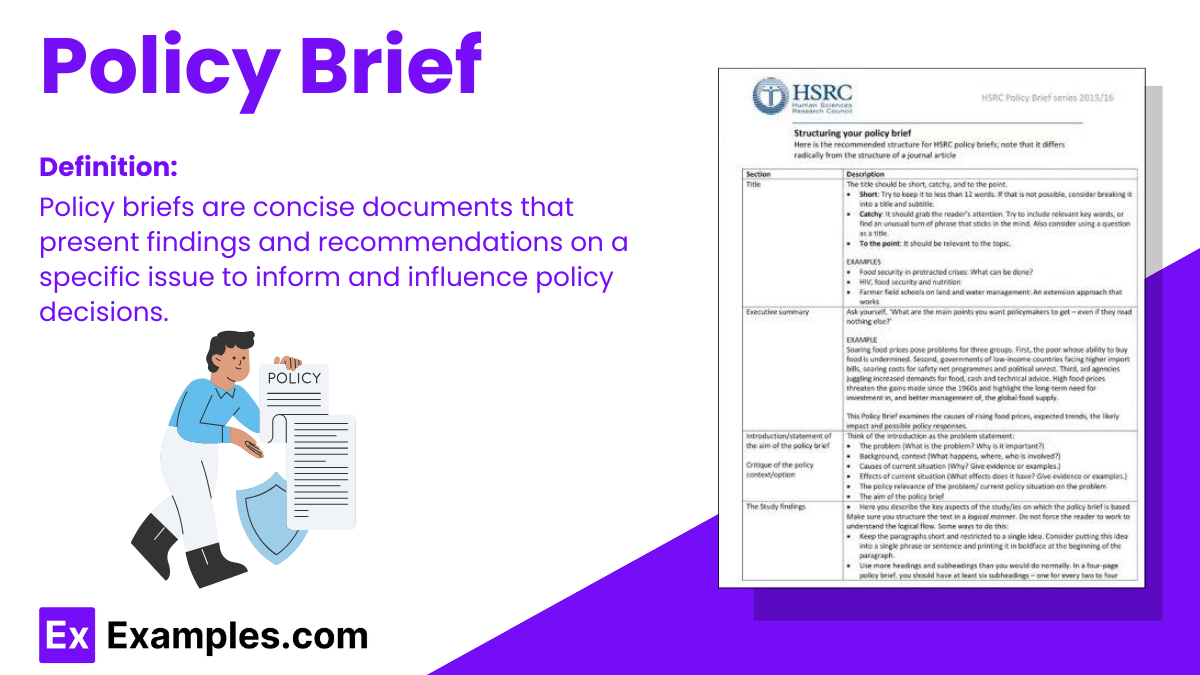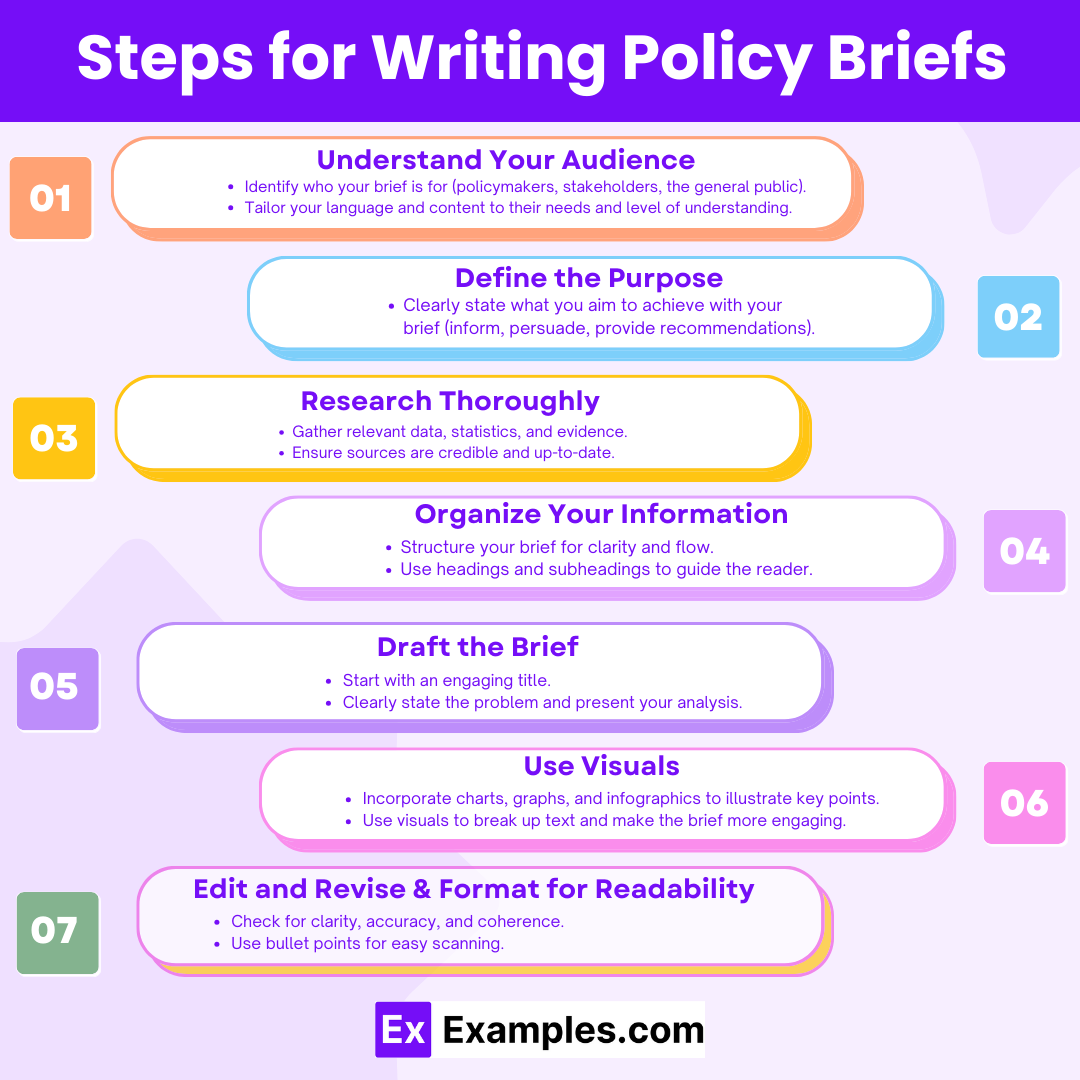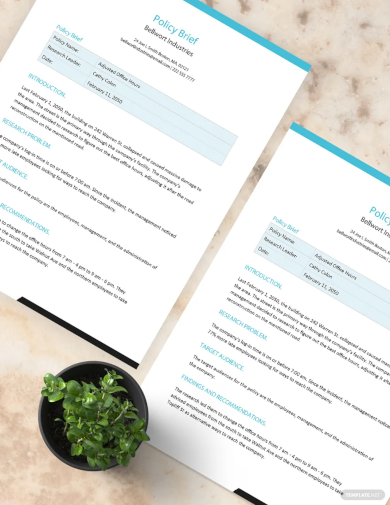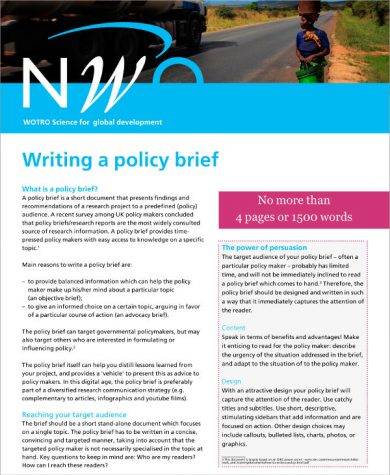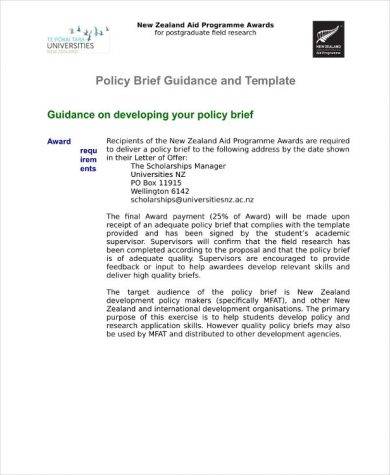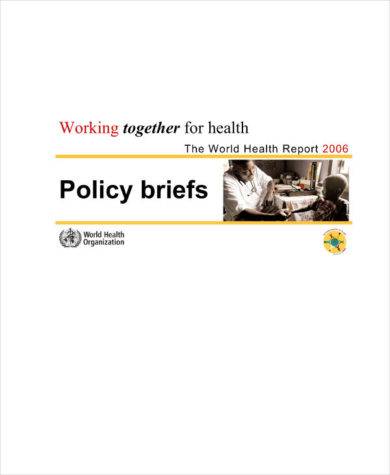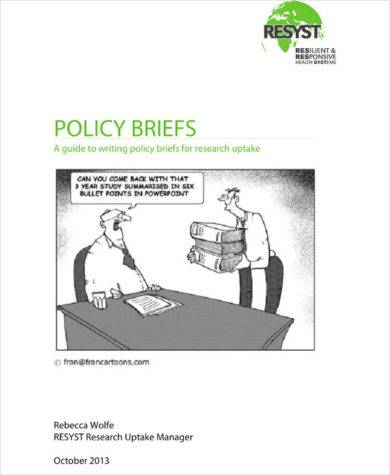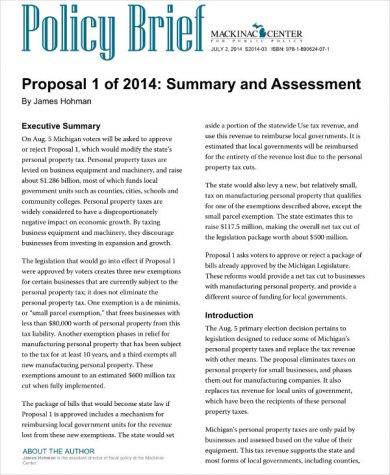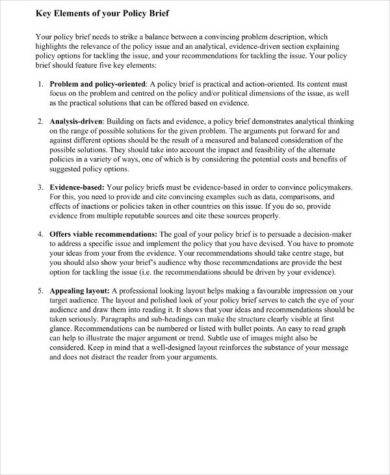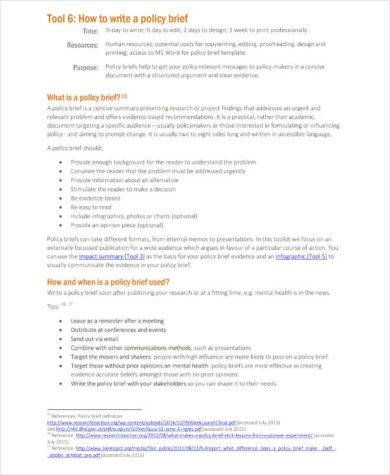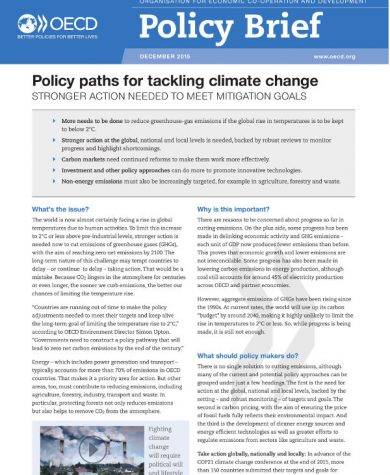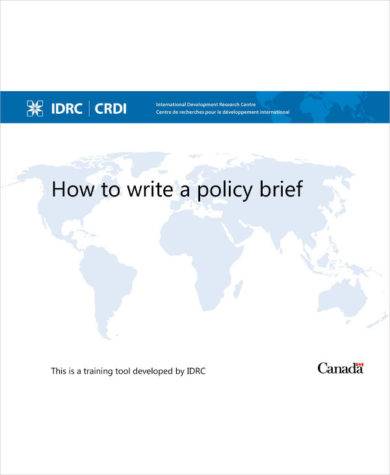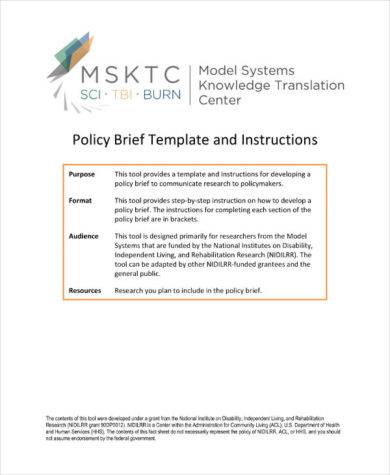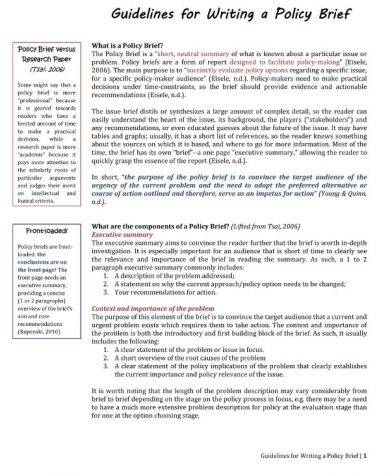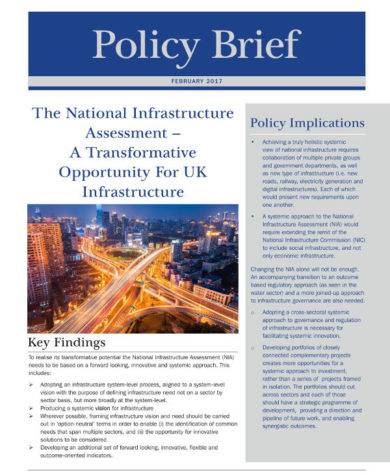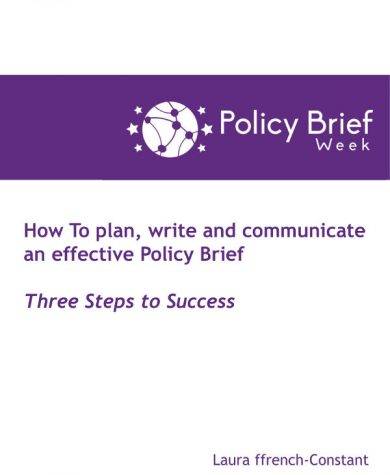16+ Policy Brief Examples to Download
A policy brief can come in different forms. It can be used in government processes, internal business relationships, and even on organizational practices. With this, it is important to remember that the content of simple policy briefs vary depending on their purpose and usage.
Even if there are variations when it comes to the information that you can see in this document, all policy briefs are expected to provide solution propositions that can help a community or a group address problems and issues that are well-defined and properly specified. Since creating a policy brief is not an easy task, we have collected a number of downloadable brief templates and examples for different policies that you can refer to if you need help when making your own policy brief.
What are Policy Briefs?
Policy briefs are concise documents that present findings and recommendations on a specific issue to inform and influence policy decisions. They are targeted at policymakers and stakeholders, providing evidence-based analyses to support actionable solutions.
How to Write a Policy Brief
Define the Issue
- Start with clarity: Clearly and concisely define the policy issue your brief addresses. Make it compelling to grab the attention of your audience.
State the Policy Objective
- Objective: Clearly state what the brief aims to achieve in terms of policy change or influence.
Conduct Thorough Research
- Evidence-based: Gather and analyze data, research findings, and case studies to support your arguments. Ensure your sources are credible.
Analyze the Policy Options
- Options and alternatives: Present and assess possible policy options or alternatives, including their potential impacts and trade-offs.
Develop Recommendations
- Actionable recommendations: Based on your analysis, offer clear, actionable, and feasible recommendations. Prioritize them based on impact and feasibility.
Write the Policy Brief
Structure effectively:
- Title: Craft a descriptive and engaging title.
- Executive Summary: Summarize the issue, your findings, and recommendations in a few sentences.
- Background: Provide context and importance of the issue.
- Problem Statement: Describe the problem and its significance.
- Policy Options: Discuss the various policy options, including pros and cons.
- Recommendations: Present your recommendations clearly and justify them.
- Conclusion: Summarize the brief, reinforcing the importance of your recommendations.
Make It Accessible
- Clarity and simplicity: Use clear, straightforward language. Avoid jargon.
- Visuals: Incorporate charts, graphs, and tables to illustrate key points.
- Formatting: Use headings, bullet points, and short paragraphs to enhance readability.
Review and Revise
- Feedback: Seek feedback from peers or experts in the field.
- Revise: Incorporate feedback and ensure the brief is clear, accurate, and persuasive.
Disseminate the Brief
- Target audience: Identify the key policymakers, stakeholders, and influencers who can act on your recommendations.
- Distribution channels: Utilize the appropriate channels to reach your audience, such as email, social media, meetings, and conferences.
Steps for Writing Effective Briefs
Step 1: Understand Your Audience
- Identify who your brief is for (policymakers, stakeholders, the general public).
- Tailor your language and content to their needs and level of understanding.
Step 2: Define the Purpose
- Clearly state what you aim to achieve with your brief (inform, persuade, provide recommendations).
Step 3: Research Thoroughly
- Gather relevant data, statistics, and evidence.
- Ensure sources are credible and up-to-date.
Step 4: Organize Your Information
- Structure your brief for clarity and flow.
- Use headings and subheadings to guide the reader.
Step 5: Draft the Brief
- Start with an engaging title.
- Include an executive summary that captures the essence of your brief.
- Provide context to outline the importance of the issue.
- Clearly state the problem and present your analysis.
- Offer concise, actionable recommendations.
Step 6: Use Visuals
- Incorporate charts, graphs, and infographics to illustrate key points.
- Use visuals to break up text and make the brief more engaging.
Step 7: Edit and Revise
- Check for clarity, accuracy, and coherence.
- Ensure your message is persuasive and your recommendations are realistic.
- Seek feedback from peers or experts.
Step 8: Format for Readability
- Use bullet points for easy scanning.
- Highlight key takeaways or recommendations.
- Ensure the design is professional and accessible.
Step 9: Distribute Effectively
- Choose the right channels to reach your audience (email, social media, presentations).
- Consider direct engagement strategies for key stakeholders.
Policy Brief Examples & Template
Policy Brief Template
Creative Policy Brief Template
Basic Policy Brief Template Example
Policy Brief Guidance and Template
Policy Brief Structure Example
Policy Brief Template and Preparation Example
Simple Policy Brief Example
Policy Brief with Writing Guidelines Example
Policy Brief Summary and Assessment Example
Policy Brief Key Elements and Example
Detailed Policy Brief Example
Comprehensive Policy Brief Example
Policy Brief Tips and Example
Policy Brief Template and Instructions Example
Policy Brief Guidelines and Example
Policy Brief Template Guide Example
Effective Policy Brief Example
Things to Know about a Policy Brief
Creating a policy brief is challenging. Hence, you need to familiarize yourself with the basic elements and factors that you will be working with once you finally decide to write a policy brief. Some of the things that you need to initially know about a policy brief before or even as you create one include the following:
1. A policy brief helps summarize or outline policy objectives, rationale, and practicality. The main point of developing a policy brief is to ensure that the target audience is aware of the entirety of a policy’s benefits and if it is really necessary for the policy to be made and implemented. You may also see what is a briefing note?
2. A policy brief, like in memo writing, must be accessible especially to the target audience. With this, the tone and the language that will be used for the policy brief are essential to be understandable. Since policy briefs include suggestions and orientation of desired actions, policy briefs are expected to be measurable, feasible, and attainable within a targeted practical state and time frame.
3. A policy brief is a focused document that is usually made for business, corporate, and professional processes. Since policy briefs are formal documents, it is essential for its content to be based on facts and evidences.
4. A policy brief can be used in different industries and fields of expertise. Most policy briefs are created if there are policy campaigns that are essential to be distributed. With the weight of the policy brief implementation in terms of its impact to business operations or organizational processes, a policy brief is actually one of the hardest and most crucial documents to write when finalizing a policy. You may also see activity reports.
Components of an Effective Policy Brief
For a policy brief to be deemed effective, it should contain all the relevant and necessary information that will allow the specific policy to be understood properly. A comprehensive policy brief can lessen the questions of the target audience which can then affect the betterment of the policy execution. The important components of an effective policy brief include the following:
1. Have a policy brief title that can make the policy brief become more memorable. The retention of the policy brief title can help the target audience be more aware and familiar with what the policy is all about. Titles that will be made for a particular policy brief must be simple, concise, and direct to the point. You may also see case summary examples.
2. Come up with a policy brief summary statement. The more precise it is that you present the policy, the easier it will be understood by the workforce or any other entities who need to follow the policy brief. A summary statement can also help ensure that a wrap-up of what the policy is all about is at hand.
3. Put into details all the previous policy scope and statements that you think should be changed. An effective policy brief must have a clause where critique of policy choices is specified. This is applicable if you would like to remove or add clauses in a policy that is currently followed by a business or an organization.
More so, you can incorporate this clause if the policy brief is still in its drafting stage and there are several items for consideration that are needed to be decided upon before a final policy is realized. You may also see marketing flow charts.
4. Discuss the importance of giving a solution to the problem at hand. Your policy brief must contain the context on why the target audience must be convinced to take actions through the help of the program specified within the policy.
5. At the end of the policy brief, ensure that you will include policy recommendations, policy improvement specifications, and notes. This can be very useful if the policy brief will be used for future references. You can also check out marketing trends.
6. List down the sources where you got all the firsthand information that helped in the development and curation of the entire policy brief. Having these items readily available can make the policy brief more credible, trustworthy, and objective.
Things to Consider before Writing a Policy Brief
May it be a smoking policy or an email policy that is essential to have a policy brief, you have to make sure that you will be guided by the core or the purpose of the policy and its implementation. Since a policy brief is used as a communication tool that helps businesses and the management to reach the target audience of particular policy options accordingly, you have to create this document in the most efficient and effective way possible. Here are some of the things that you need to consider before writing a policy brief:
1. Know the issue that made way for the policy choices to be created. You have to make sure that you are knowledgeable of the things that are associated with the issue so you can answer any inquiries and questions once the policy brief has been disseminated.
2. Be aware of the policy brief’s target audience. You have to ensure that the people to whom the policy is for can view and feel the objectivity and fairness once they get their hands on the policy brief. You may also see marketing brief examples.
3. List down all the stakeholders that are responsible for the policy brief planning, development, and implementation. This way, you can regulate the policy in a more organized manner. This will also help you to allocate call to actions and work functions to people who are aware of the specific ways on how they can contribute to the betterment of the policy brief. You may also see policy proposal examples & samples.
4. Have an idea of the policy action that is up for recommendation. People should know the reason why the policy has been made and it should be clear why they are expected to follow the policy brief content. You may also see event briefs.
Guidelines in Writing a Policy Brief
Having a policy brief can help your business or organization a lot. It promotes an understanding not only of the solution that is needed for certain issues but the problem currently faced and its roots as well. Some of the guidelines that can help you develop a great policy brief are as follows:
1. Use downloadable examples as one of your main references when writing a policy brief. Having content guides can help you create a policy brief that is more packed with relevant and necessary information. You may also see welcome speech examples.
2. Make sure to review the policy brief first before disseminating it to the target audience. It will be best if you can seek for the advice of the management and all the other decision-makers of the business or the organization. This way, the policy brief can be more refined. You might also be interested in technical reports.
3. Have a general plan as to which the policy brief will be given at the fastest time without sacrificing the quality of its presentation. This way, your outreach plan can improve the acceptance rate of the policy brief.
Whether your policy brief is for a change management plan or any other kinds of undertakings, activities, and processes, ensure that you will look into all the minute details of the document so you can make the most out of its usage.
How do I identify a problem for my policy brief?
To identify a problem for your policy brief, start by conducting thorough research in areas relevant to your interests or the mandate of your organization. Look for gaps in current policies, emerging challenges, or areas where there’s significant public debate or concern. Analyze data, reports, and news to understand the scope and impact of potential issues. Engage with stakeholders, including community members, industry experts, and policymakers, to gain insights into the practical challenges they face. Prioritize problems based on their relevance, the feasibility of addressing them, and the potential for your brief to influence change. The chosen problem should be specific enough to allow for a detailed analysis and development of actionable recommendations, yet significant enough to warrant attention from policymakers and stakeholders.
FAQs
What is a General Statement of Policy?
A general statement of policy outlines an organization’s intentions and guiding principles regarding a specific issue or its overall operation. It provides a framework for decision-making and actions, setting the tone for policies and practices within the organization.
What is the Purpose of a Policy Summary?
The purpose of a policy summary is to concisely present the key points of a policy document, including its objectives, scope, and recommendations. It serves to inform stakeholders and decision-makers quickly, facilitating understanding and action without needing to review the full document.
What is the Writing Style of a Policy Brief?
The writing style of a policy brief is clear, concise, and focused, aiming to communicate complex information in an accessible manner. It avoids jargon, uses straightforward language, and includes evidence and recommendations to persuade and inform policymakers and stakeholders.
What Makes a Good Policy Briefing?
A good policy briefing is clear, concise, and compelling. It effectively communicates the issue, provides evidence-based analysis, and offers actionable recommendations. Good briefings are targeted to their audience, making complex information accessible and persuasive to decision-makers.
What is an Example of a Policy Statement?
An example of a policy statement might be, “Our organization is committed to reducing our carbon footprint by 25% over the next five years through sustainable practices and renewable energy usage.” This statement outlines a specific, measurable commitment related to environmental sustainability.
What is an Example of a Good Policy Statement?
A good policy statement example is, “It is our policy to provide a safe and healthy work environment for all employees by adhering to occupational health and safety standards and regulations.” This statement clearly communicates a commitment to employee welfare and legal compliance.


